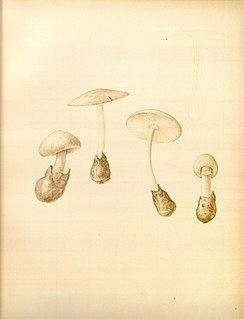
Amanita citrina, commonly known as the false death cap, or citron amanita, is a basidiomycotic mushroom, one of many in the genus Amanita. It grows in silicate soil in the summer and autumn months. It bears a pale yellow or sometimes white cap, with white stem, ring and volva. Though not deadly, it is inedible and often confused for the lethal death cap.

Hygrocybe conica, commonly known as the witch's hat, conical wax cap or conical slimy cap, is a colourful member of the genus Hygrocybe, found across northern Europe and North America. Originally described as Hygrophorus conicus, it may be a complex of closely related and similar species.

Agaricus campestris is a widely eaten gilled mushroom closely related to the cultivated button mushroom Agaricus bisporus. It is commonly known as the field mushroom or, in North America, meadow mushroom.

Conocybe tenera is a widely distributed member of the genus Conocybe. This mushroom is the type species for the genus Conocybe.

Lentinellus is a genus of white rot, wood decay, lamellate agaric in the family Auriscalpiaceae, further characterized in part by rough-walled, amyloid spores produced on lamellae with jagged edges. Typically, thick-walled hyphae in the fruit body are in part amyloid, and frequently the taste of the mushrooms is acrid. The widespread genus has been estimated to contain 15 species. Mycologists Ronald Petersen and Karen Hughes considered 24 species in their 2004 world monograph of the genus.

Hygrocybe coccinea, sometimes called the scarlet hood, scarlet waxcap or righteous red waxy cap, is a colourful member of the mushroom genusHygrocybe. These waxcaps are found across the Northern Hemisphere from China and Japan to Europe and North America. The small bright red mushroom is a familiar sight in unimproved grasslands in Europe in late summer and autumn, and woodlands in North America in winter.

Lentinellus cochleatus, commonly known as the aniseed cockleshell, is a wood-inhabiting fungus. It has a mild aniseed odor and flavor. Like all species in its genus, it is inedible due to its bitterness.

Geastrum corollinum is an inedible species of mushroom belonging to the genus Geastrum, or earthstar fungi. First described scientifically by German naturalist August Johann Georg Karl Batsch in 1792 as Lycoperdon corollinum, it was transferred to the genus Geastrum by László Hollós in 1904.
Endoptychum is a genus of secotioid fungi in the family Agaricaceae. Like the majority of secotioid taxa, the individual species of Endoptychum are thought to be recent mutations from agaricoid species, hence, Endoptychum is likely not a valid monophyletic genus.

Lycoperdon pulcherrimum is a type of puffball mushroom in the genus Lycoperdon. It was first described scientifically in 1873 by Miles Joseph Berkeley and Moses Ashley Curtis. The fungus is found in the southern United States.

Dacrymyces palmatus is a species of fungi in the family Dacrymycetaceae, and is nonpoisonous. It is alternately reported to be both edible and inedible.

Amanita volvata, also known as volvate amanita is an inedible white-coloured species of fungi from the family Amanitaceae found in the southeastern United States. Can be confused with Amanita ponderosa, but that species is from the Iberian peninsula. The species is amyloid and have saccate volva, and elliptic spores.

Hygrocybe cantharellus is a mushroom of the waxcap genus Hygrocybe. It is found in eastern North America and Australia. It is considered nonpoisonous.

Amanita excelsa is a species of agaric fungus in the family Amanitaceae. It is found in Asia, Europe, and North America, where it grows in deciduous forests.

Hygrophorus chrysodon is a species of fungus in the genus Hygrophorus. It is edible but bland in taste.

Cortinarius trivialis is a species of inedible fungus in the genus Cortinarius. It was reported as edible as recently as 1991, but European field guides consider it poisonous.

Pholiota astragalina is a species of fungus in the family Strophariaceae. It was first described scientifically in 1821 by Elias Magnus Fries as a species of Agaricus. Rolf Singer transferred it to the genus Pholiota in 1951. Fruitbodies of the fungus have pinkish-orange caps measuring 2–5.5 cm (0.8–2.2 in) in diameter. They produce a reddish-brown spore print. Spores are oval to elliptical, smooth with thin walls, and measure 5–7 by 4–4.5 µm. In North America, the fungus is found in the United States and Canada. In Europe, it has been recorded from France, Sweden, and Switzerland.
Russula redolens, commonly known as the parsley-scented russula, is a basidiomycete mushroom of the genus Russula native to North America. Its flesh smells of parsley.

Lentinellus micheneri is a species of wood-inhabiting fungus in the family Auriscalpiaceae. It was first described in 1853 by mycologist Miles Berkeley and Moses Ashley Curtis as Lentinus micheneri. David Pegler transferred it to the genus Lentinellus in 1983. Like all species in its genus, it is inedible.

Bondarzewia berkeleyi, commonly known as Berkeley's polypore, or stump blossoms, is a species of polypore fungus in the family Russulaceae. It is a parasitic species that causes butt rot in oaks and other hardwood trees. A widespread fungus, it is found in Africa, Asia, Europe, and North America.
















